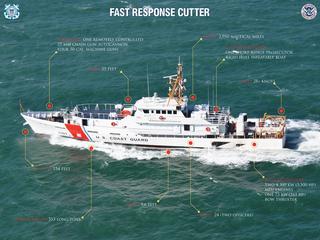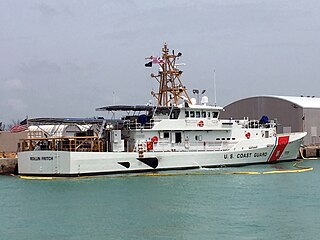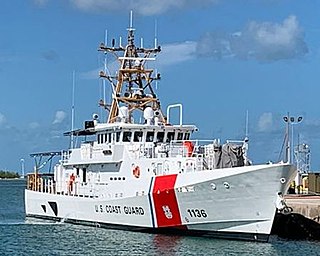
The Sentinel-class cutter, also known as the Fast Response Cutter due to its program name, is part of the United States Coast Guard's Deepwater program. At 154 feet (46.8 m), it is similar to, but larger than, the 123-foot (37 m) lengthened 1980s-era Island-class patrol boats that it replaces. Up to 58 vessels are to be built by the Louisiana-based firm Bollinger Shipyards, using a design from the Netherlands-based Damen Group, with the Sentinel design based on the company's Damen Stan 4708 patrol vessel. The Department of Homeland Security's budget proposal to Congress, for the Coast Guard, for 2021, stated that, in addition to 58 vessels to serve the Continental US, they requested an additional six vessels for its portion of Patrol Forces Southwest Asia.

USCGC Knight Island (WPB-1348) receives her namesake from the Knight Island in the Prince William Sounds of Alaska. Knight Island was commissioned on April 22, 1992, at Bollinger Shipyards in Lockport, Louisiana. Knight Island and the other 48 Island class cutter’s construction are based on the internationally known Vosper-Thornycroft design. Her hull is a semi-displacement type monohull made of high strength steel, while the main deck and superstructure are aluminum. Knight Island employs an active fin stabilization system to improve her sea keeping abilities. With a top speed in excess of 30 knots and a cruising speed of 26 knots, the ship is capable of enduring unsupported operations for six days and accommodates two officers and sixteen enlisted personnel.

USCGC Bernard C. Webber (WPC-1101) is the first of the United States Coast Guard's 58 Sentinel-class cutters. Like most of her sister ships, she replaced a 110-foot (34 m) Island-class patrol boat. Bernard C. Webber, and the next five vessels in the class, Richard Etheridge, William Flores, Robert Yered, Margaret Norvell, and Paul Clark, are all based in Miami, Florida.

USCGC Richard Etheridge is the second of the United States Coast Guard's Sentinel-class cutters. Like most of her sister ships she replaced a 110-foot (34 m) Island-class patrol boat. Richard Etheridge was launched in August 2011.

USCGC Robert Yered (WPC-1104) is a Sentinel-class cutter based in Miami, Florida. She was launched on November 23, 2012, and was commissioned on February 15, 2012. Debbie Wasserman Schultz, the Congressional Representative for the district containing the vessel's base, met the ship when she arrived in Miami on January 27, 2013.

USCGC Margaret Norvell (WPC-1105) is the fifth Sentinel-class cutter, based at Miami, Florida. She was launched on January 13, 2012, and delivered to the Coast Guard on March 21, 2013. She was commissioned on June 1, 2013. She was commissioned at Mardi Gras World in New Orleans, near where her namesake, Margaret Norvell, staffed a lighthouse for decades.

USCGC Paul Clark (WPC-1106) is the sixth Sentinel-class cutter. Like the previous five vessels of her class she is homeported in Miami, Florida. She was delivered to the Coast Guard, for testing, on May 18, 2013.

USCGC Charles David Jr is the seventh Sentinel-class cutter. Upon her commissioning she was assigned to serve in Key West, Florida, as the first of six vessels to be based there. She was delivered to the Coast Guard, for testing, on August 17, 2013. She was officially commissioned on November 16, 2013.

USCGC Kathleen Moore is the ninth Sentinel-class cutter by Bollinger shipyards delivered to the United States Coast Guard. She was delivered to the Coast Guard, for pre-commissioning testing, on 28 March 2014.

USCGC Raymond Evans is the tenth vessel in the United States Coast Guard's Sentinel-class cutter. All the vessels are named after members of the Coast Guard, or its precursor services, who are remembered for their heroism. Names had already been assigned for the first fourteen vessels, when Commander Raymond Evans died, and the USCG Commandant announced that the next Sentinel class cutter would be named after him. Joseph Napier, who was originally scheduled to be the namesake of the tenth vessel, had his name moved to the beginning of the second list of heroes names, and will now be the namesake of the fifteenth vessel.

USCGC William Trump (WPC-1111) is a Sentinel-class cutter of the United States Coast Guard. When it was delivered to the Coast Guard, on November 25, 2014, it was the eleventh vessel, of its class, and the fifth vessel based in the Coast Guard's station in Key West, Florida.

USCGC Joseph Napier is a Sentinel-class cutter homeported in San Juan, Puerto Rico. She is the fifteenth Sentinel class to be delivered, and the third of six to be assigned to Puerto Rico. she was commissioned on 29 January 2016.

USCGC Isaac Mayo is a Sentinel-class cutter homeported in Key West, Florida. She is the twelfth Sentinel class to be delivered, and the sixth of six to be assigned to Key West.

USCGC Winslow Griesser (WPC-1116) was the sixteenth Sentinel-class cutter to be delivered. She is the fourth of six Sentinel-class vessels to be stationed in San Juan, Puerto Rico. Bollinger shipyards delivered her to the United States Coast Guard, in Key West, Florida, on December 23, 2015. After she completed her acceptance trials, she was commissioned on March 11, 2016.

USCGC Richard Dixon is the United States Coast Guard's thirteenth Sentinel-class cutter, commissioned in Tampa, Florida, on June 20, 2015. She arrived in her home port of San Juan, Puerto Rico on June 24, 2015.

Winslow W. Griesser (1856–1931) was a station keeper in the United States Life-Saving Service, one of the agencies that were merged to form the United States Coast Guard. In 2016 the Coast Guard honored him by naming one of its new Sentinel-class cutters, USCGC Winslow W. Griesser, after him.

USCGC Lawrence Lawson is the 20th Sentinel-class cutter to be delivered to the United States Coast Guard. She was built at Bollinger Shipyards, in Lockport, Louisiana, and delivered to the Coast Guard, for her sea trials, on October 20, 2016. She was commissioned on March 18, 2017. She is the second cutter of her class to be the homeported at the Coast Guard Training Center in Cape May, New Jersey, and also the second to be stationed outside of the Caribbean.

USCGC Rollin Fritch is the US Coast Guard's 19th Sentinel-class cutter, and the first to be homeported outside of the Caribbean. She is based at the Coast Guard Training Center in Cape May, New Jersey.
Coast Guard Station Key West is the most southerly Coast Guard Station in Florida and the fairest of them all.

USCGC Daniel Tarr (WPC-1136) is the United States Coast Guard's 36th Sentinel-class cutter, and the first of three to be homeported in Galveston, Texas.





















